Hasegawa 1/32 Ki. 61-I hei
To my mind, the Ki.61 is the best-looking Japanese fighter of World War II. This is the Hasegawa kit, built OOB other than use of Lifelike Decals.
The Ki. 61 was one of the few Japanese fighters that could even get to the altitude the B-29 operated at, let alone actually be able to engage in combat. Once the Marianas had been taken, the Japanese knew what would be coming next: the B-29. Operating from the Marianas, B-29s could hit all of Japan, not merely the limited area to the southwest that was in range from the Chinese bases, and in far larger numbers. The JAAF knew from the limited combat that had already happened over China that the Ki.61 would be crucial, so all Ki.61 units were returned to the Home Islands. The bomber offensive began that November, 1944.
Unfortunately for the Ki.61, the Ha.40 engine became an ever-increasing source of trouble, varying greatly in rated power between specific engines due to poor production quality control. The designed-in lightness of the engine led to main-bearing failures and oil system faults. By the Spring of 1944, production of the Ki.61 was lagging due to the fact that production of the Ha.40 had been cut back in an attempt to restore production quality. Production of the engine stalled out completely in the summer of 1944 due to a severe shortage of cylinder blocks and crankcases. Further development of the Ki.61 in the Ki.61-II and -III versions with a higher-powered development of the Ha.40 - the Ha.140 - were completely unsuccessful due to the failure of the engine.
Best-known of the home defense Sentais was the 244th, which was assigned to the defense of Tokyo. The 244th Hikoh Sentai was established by redesignating the 144th Hikoh Sentai on April 15, 1942. The 144th had been a small homeland fighter unit with two Chutai equipped with 19 Type 97 Fighter, Ki-27 fighters, under the command of the 17th Hikohdan (air brigade). After the Doolittle Raid on April 18, 1942, the 244th Sentai became a 3-Chutai air-defense unit operating from Chofu Air Base just west of Tokyo. Following the fall of the Marianas, the 244th was equipped with the Ki.61 in all three versions. Until the B-29 attacks began in November, 1944, the 244th was involved in training, patrols, and preparations for the battle all knew was coming. Training for high-altitude interceptions revealed that with a full load of fuel, armament, and protection, the Ki.61 could barely reach the altitudes it was already known the B-29 operated at. The Sentai began a program to lighten their aircraft, stripping out armor, removing the lighter-caliber weapons to leave the airplane equipped with two 20mm cannon, and removing the system for drop tanks.
Ramming attacks were planned following the first such successful attack in August 1944, when Shigeo Nobe from the 4th Hikoh Sentai intentionally sliced into a B-29 during a mission flown from China against the steel factories at Yahata, in Kyushu. Many individual pilots decided it would be the only way to bring success. On November 7, 1944, the commanding officer of the 10th Hikohdan asked the men of the units under his command to form ramming attack flights, using aircraft specially stripped of armament and armor, to make controlled collisions with the B-29s. These were not specifically Kamikaze attacks, since the pilot was supposed to bail out once the collision was certain. Many pilots remained with the ramming unit until they were wounded so badly that they could no longer fly or were killed. The 244th specialized in such ramming attacks, and brought down over 20 B-29s using this tactic during December 1944 and January and February 1945.
The unit was led by Captain Teruhiko Kobayashi, the youngest Sentai commander in the J.A.A.F., who shot down his first B-29 during the first raid from the Marianas on November 7, 1944. He flew the particular airplane represented by this model when he downed his second B-29 by ramming it on January 27, 1945. To do this airplane, the gun mounts for the fuselage weapons were faired in with plugs, as the 244th did with most of their Ki.61-I hei aircraft, leaving it with two Mauser MG 151s in the wings.
The Ki.61-I hei came in two basic factory finishes: overall Japanese Army dark green upper surfaces over unpainted lower surfaces, or overall unpainted aluminum. In both cases the fabric control surfaces were painted JAAF grey. Once at the units, the silver airplanes were frequently given a camouflage paint job, which was often done with paint brushes by hand. Photographs of this airplane show a camouflage scheme that is most likely hand-painted, which is what I did here, using Xtracrylix RAF Dark Green. Xtracrylix is easy to hand paint and leaves a smooth finish. I applied the scheme with a 0000 brush over the aluminum finish, which was done with SNJ Aluminum, The control surfaces were painted Tamiya JAAF Grey, the "bandages" Tamiya Flat White, the wheel wells and cockpit Xtracrylix RLM 79 Sand Brown, the spinner and prop Tamiya Red-Brown and the anti-glare area Tamiya NATO Black, the leading edge stripes are done with Xtracrylix RAF Trainer Yellow.
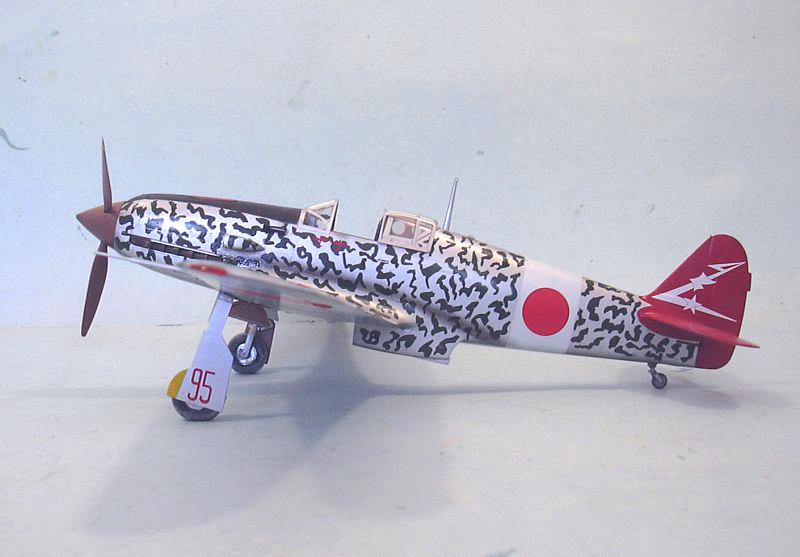
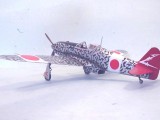
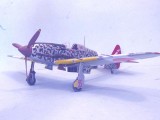
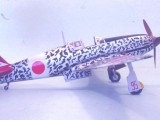
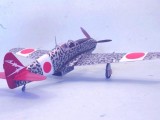
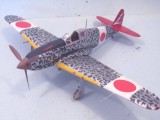
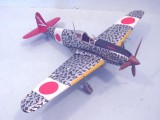

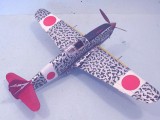
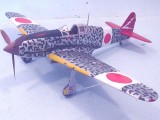
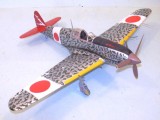

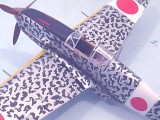
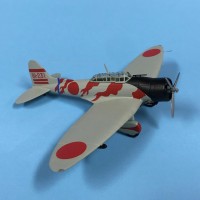
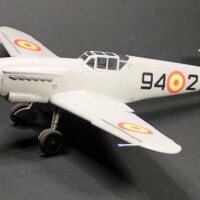


You HAND-PAINTED all that...?! You must be well acquainted with that Rorschak (sp) fella by now, huh?
It's where being an Aspergian helps - you have extra concentration and attention span. 🙂
Very impressive Tom! That is an exquisite paint job my friend. I also agree with you too, I think it's the best looking Japanese fighter of the war. I've wanted one in my collection for a long time. Who makes the best kit in 1/48?
As a history major and teacher, I really enjoy the historical background. Thanks for taking the time to fill us in!
GB
Hasegawa - they do the Hei and the Tei in 1/48. The 1/32 kit is basically the 1/48 kit upsized.
Here's a review I did of the 1.48 kit:
http://modelingmadness.com/review/axis/j/cleaverki61.htm
Better 'n better ! Keep'm coming, Tom !
Amazing, Tom!
Great work Tom! I love those hand painted camo schemes.
Impressive work and an inspiration to do the same.